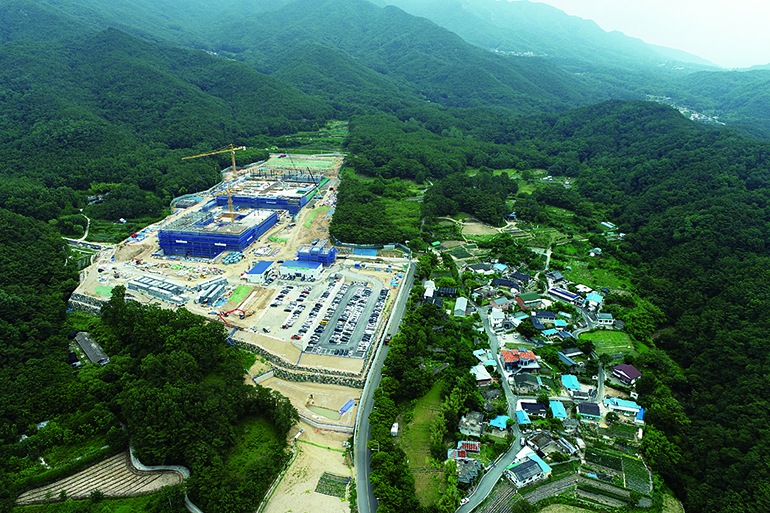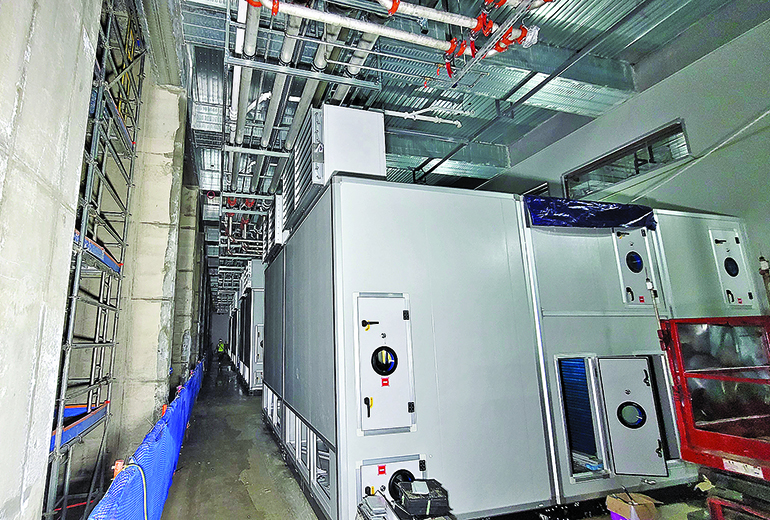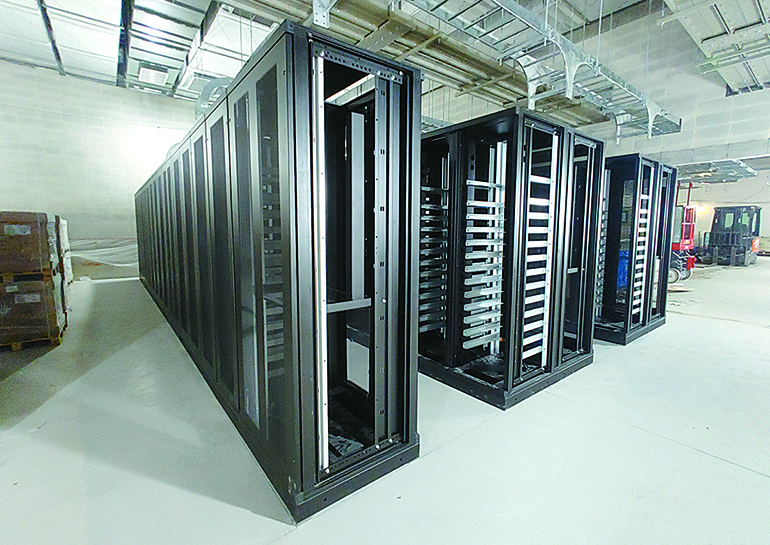
Latest News
- Hyundai E&C Becomes Key Player in the Nuclear Decommissioning Market
- Hyundai E&C Accelerates Global Nuclear Expansion into the U.S. Nuclear Market
- Hyundai E&C Shifts into High Gear to Enter Nordic Large-Scale Nuclear Market
- Hyundai E&C Strengthens Korea-Japan Cooperation in Energy Transition and New Growth Businesses
- Hyundai E&C Signals Green Light for Large-Scale Nuclear Power Plant Business in Europe
[Our Project] National Information Resources Service, Daegu Center
The first zero-energy data center in Korea whose lights never go off 24/7
If you drive for about 30 minutes from Dongdaegu Station along the address of 448 Dohak-dong, Dong-gu, Daegu, you will see a completely different view from the city center. It is the Palgongsan Mountain, the pride of Daegu, where tourists continue to visit all year round. When you arrive at your destination and shift your gaze from the east to west, you can see a construction site surrounded by the foot of Palgongsan Mountain opposite Dojang Village with a peaceful and quiet surrounding. This is the site of Daegu Center of the National Information Resources Service. It is a fortress that protects information assets in Korea and a government data center whose lights never turn off under any circumstances.
If Cloud connects reality and the virtual world, the data center is like the heart that keeps the Cloud alive. If the data center stops for a moment, the physical space and the virtual space connected by big data and artificial intelligence will be disconnected. This is why data centers are drawing attention in the era of the 4th industrial revolution.
“The National Information Resources Service, Daegu Center” which is in full swing for completion in March 2022, is an “intelligent cloud computing center” that automatically controls and manages software with little human intervention. The Public Procurement Service, the client, announced the call for project in 2018 through a detail design technical proposal. The bidding for a technical proposal for detail design is a method in which the bidder prepares a technical proposal according to the client's detail design and bidding guide, and the technology of the contractor is paramount because it encompasses the entire process from design to construction.

[ Drone-shot panoramic view of the site of the National Information Resources Service, Daegu ]
For the order of the third national data center to be built following the ones in Daejon and Gwangju, which is a national security facility at the same level as the Blue House and the National Assembly, three leading domestic companies, including Hyundai E&C, participated as a consortium and engaged in a fierce competition. Since 2007, Hyundai E&C has won orders based on the know-how of successfully constructing the Bundang IT Center of the Korea Financial Telecommunications & Clearings Institute, the KT Mok-dong IDC new construction project, the NH Integrated IT Center, and the KB Kookmin Bank Integrated IT. At the end of a close battle, Hyundai E&C held the flagpole of victory as it was highly evaluated for its technologies such as improving the Thermal Labyrinth system that leaves a gap between the building and the ground to save energy, minimizing the use of cooling power energy, and utilizing new and renewable energy such as geothermal and solar power.
In particular, while competitors suggested an average annual PUE (Power Usage Effectiveness) of 1.3 to 1.34, Hyundai E&C suggested PUE 1.227, the highest in Korea, and received high attention from the ordering and demanding agency, the National Information Resources Management Service of the Ministry of Public Administration and Security. The more PUE converges to 1, the better it is, and the green data center platinum grade (highest grade) is granted to PUE 1.4 or less.

[ Constant temperature/humidity room ]
With a land area of 81,367 ㎡ (total floor area 35,602 ㎡), and a contract balance of 159 billion won (47% or 68.7 billion won for Hyundai E&C), the Daegu Center of the National Information Resources Service is project to build an administrative building (1 basement level - 3 above ground), IT Building (3rd basement level - 2nd floor), the visitor center (1st basement level - 2nd floor), and the ESS (Electric Power Storage System) facility building (1st floor). In order to build a data center of the highest quality, Hyundai E&C established the fiver core strategies: Tier IV design (Tier is the data center stability rating standard stipulated by 'Up Time', a world-class certification body in the U.S., where IV is the highest); Non-disruptive expansion through modularization of architecture, structure, and facilities; Certification of green data center platinum; Development of a security system adapted to key national facilities of highest priority; Establishment of an embedded data center against disasters and emergencies.

[ Generator for cooling the server ]
Hyundai E&C’s data center construction know-how and technology are all encompassed at the National Information Resources Service, Daegu Center. Data centers are at war with “heat”, 24 hours a day, 365 days a year. As much heat is generated as electricity is supplied to the server, high heat can damage the server and cause data loss. Cooling the server and minimizing the energy required for cooling are the core of data center construction. Hyundai E&C devised an “embedded data center” to minimize server cooling, which is essential for 'non-disruptive' operation, and the energy required to this end. The site, which is sunken in a semi-underground form, uses cold outside air to cool the server in winter, and uses the cooling energy accumulated during the winter for the lowest-floor PIT (underground facility space in tact of humans) in the summer. In addition, the “embedded-type” building has secured excellent seismic resistant and protective performance, which is operational even in disasters and emergencies such as a 7.0 magnitude earthquake or counter-terrorism.

[ Uninterruptible power supply (UPS) has been installed in the battery rack to provide immediate current when the main current supply line suddenly fails or when a power outage occurs. ]
In addition, the site applied 21 cutting-edge technologies that provide a glimpse into the current state of Hyundai E&C’s digital construction in cooperation with the Building and Bousing Competitiveness Promotion Team at the headquarters. We introduced the latest design technique called the BIM (Building Information Modeling) to design and construction and utilized our company’s internal on-site safety management system HIos using Robotics·Prefab technology and ICT (Information and Communication Technologies) in the right place to ensure increased quality and safety.
As it claims to be the first “zero energy data center” in Korea, it has also applied Smart BEMS (Building Energy Management System), an integrated energy management system that efficiently manages energy used in buildings. The National Information Resources Service’s Daegu Center plans to secure the “excellent grade” from all seven certification bodies in building energy efficiency ratings, zero-energy building certification, barrier-free living environment certification, and high-speed ITC certification, etc.
The site, which completed the groundbreaking ceremony on October 31, 2019, began placing the foundation concrete in May 2020 due to the circumstances of the client and the pandemic. The construction was delayed due to a series of negative factors such as record-level typhoons, cold waves, and disruptions in the supply and demand of government-level materials. However, the site took on a speed war based on a fast-track approach and demonstrated its administrative and official abilities to have the construction extended two times by the ordering party.
In addition, through the design change, HIOS was recognized as an item for safety management cost (according to Article 63 of the Construction Technology Promotion Act), resulting in the cost-saving of 60 million won. It was the first case in Hyundai E&C’s history. As of August 27, the completion rate stood at 63%, and the site is focusing on completing the top-floor framing and interior and exterior finishing by March of the following year. The on-site workers exuded confidence by saying, “We went through a lot of adversity, but we worked together and crossed the major hurdles without any major accidents,” adding that “Excellent construction performance and human resources on site will be of great help in the future data center biddings.”

